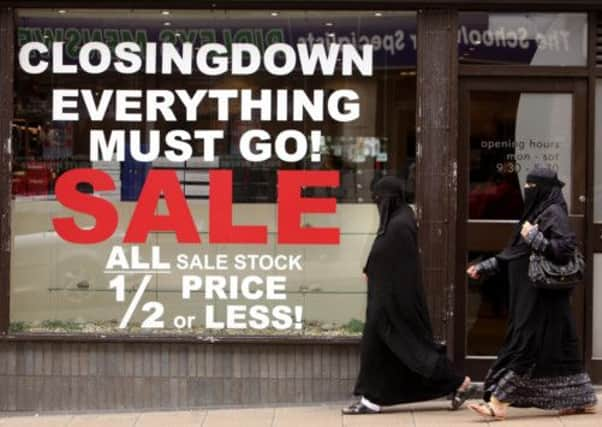Mark Bradley: Is it time to sell a fresh new face of shopping on our faded high streets?


However, beyond the city boundaries, towns and smaller conurbations across the county are not faring so well.
A year after the pilot locations were chosen for Mary Portas’ high street regeneration project the overall picture is worrying: a freedom of information request has revealed that only a tiny percentage of the money set aside has been spent and, even when money’s been drawn down, we’re left with superficial change only (one town centre bought a snow machine, believe it or not).
Advertisement
Hide AdAdvertisement
Hide AdSo is the current situation something we can address, in the case of the Portas project, with some local authority-led innovation and a little funding or have we reached a stage where we need to engage in some fundamentally different thinking?
On the face of it, addressing the most visible aspects of high street decay seems sensible.
Let’s look at parking charges, let’s encourage landlords not to leave premises empty, let’s do something about business rates and let’s reclaim the streets with vibrant, engaging activities. Dartford’s innovative ‘school for shopkeepers’ ought to build confidence, share best practice and promote growth, for example, while Liskeard’s guerrilla gardening and yarn bombing (don’t ask) just might distract the passer by.
But if we pull on the customer’s shoes and take a couple of steps back, we see a bigger picture that presents some unimaginably complex challenges.
Advertisement
Hide AdAdvertisement
Hide AdWhat’s become clear is that the recession alone isn’t the root cause of the problem and retail is only a small part of the solution. In fact, there’s a deeper malaise that began with our rush to move people out of town centres in the 60s and 70s. Whatever the town centre institution you can think of, the chances are it was moved ‘out of town’ by an enterprising local authority a couple of decades ago: hospitals, schools, private and public offices, colleges, universities and even football grounds. They’re all more likely to be found near the ‘ring road’ than the geographical centre of town.
Years ago, you’d park your car in the town centre and walk down the high street to work. Now you can go weeks without ever seeing it. You can have as many market, food and cultural quarters as you like, but they won’t thrive if there aren’t any people passing by.
There’s also the impact of our love of convenience, immediacy and online social connectivity. Tesco is now introducing “click and collect” services where you can order your goods online and then simply drive in to pick them up. Never mind an idle wander around the local greengrocers, now you can do your supermarket shopping entirely online or partially online – just never in person.
Our communities are increasingly “social media” led, rather than physical in nature. My mum used to pop into town on a Monday night for her group yoga class. Now she contorts herself into curious positions while listening to a yoga coach on her iPod.
Advertisement
Hide AdAdvertisement
Hide AdAll of this could have easily been foreseen with the emergence of Amazon in 1995, the year, incidentally that my eldest was born. His 17 years so far have been lived against a backdrop of a coming together of increasingly demanding consumers and determinedly better technology, while town centres have stood by and watched as the population has moved away, shop owners sell things we don’t need any more and we all run out of money.
I believe that a lot of people associate the Mary Portas pilot with a nostalgically romanticised past where relationships blossomed by the town hall, passing soldiers were saluted and the barrow boy promoted his provender with a cheeky grin.
The truth is that town centres have become, in the words of Professor Leigh Sparks (from the Institute of Retail Studies) “anachronistic irrelevancies unsuited to the changed consumer, business, social and economic world. We do no one any favours by clinging to an outdated vision of a past that arguably never existed”.
So what’s to be done? I think there’s a clue in what’s happened in Stockport, an original Portas Pilot.
Advertisement
Hide AdAdvertisement
Hide AdThere, one Joe Barratt (recruited to produce a video of regeneration endeavours) complained that the town Ccntre team (meant to bring together businessmen and civic representatives and the consumer) had failed to consult the community.
Twelve months on and they’ve spent little or none of their £100,000 grant, while the Stockport community itself has pressed ahead with a creative arts complex, outdoor screenings and the like.
Professor Sparks points out that local community groups are so much more entrepreneurial than local authorities, so by excluding them from the debate and decision-making, we’re missing a tremendous opportunity for effective change.
Could this be another example of the UK customer being overlooked? It wouldn’t be the first time.
Advertisement
Hide AdAdvertisement
Hide AdMary Portas’ ideas are sound and she’s rightly urged community engagement. So let’s not be afraid to ask an obvious question: if it was local authorities and business that got us into this mess in the first place, why rely on them alone to sort it out?